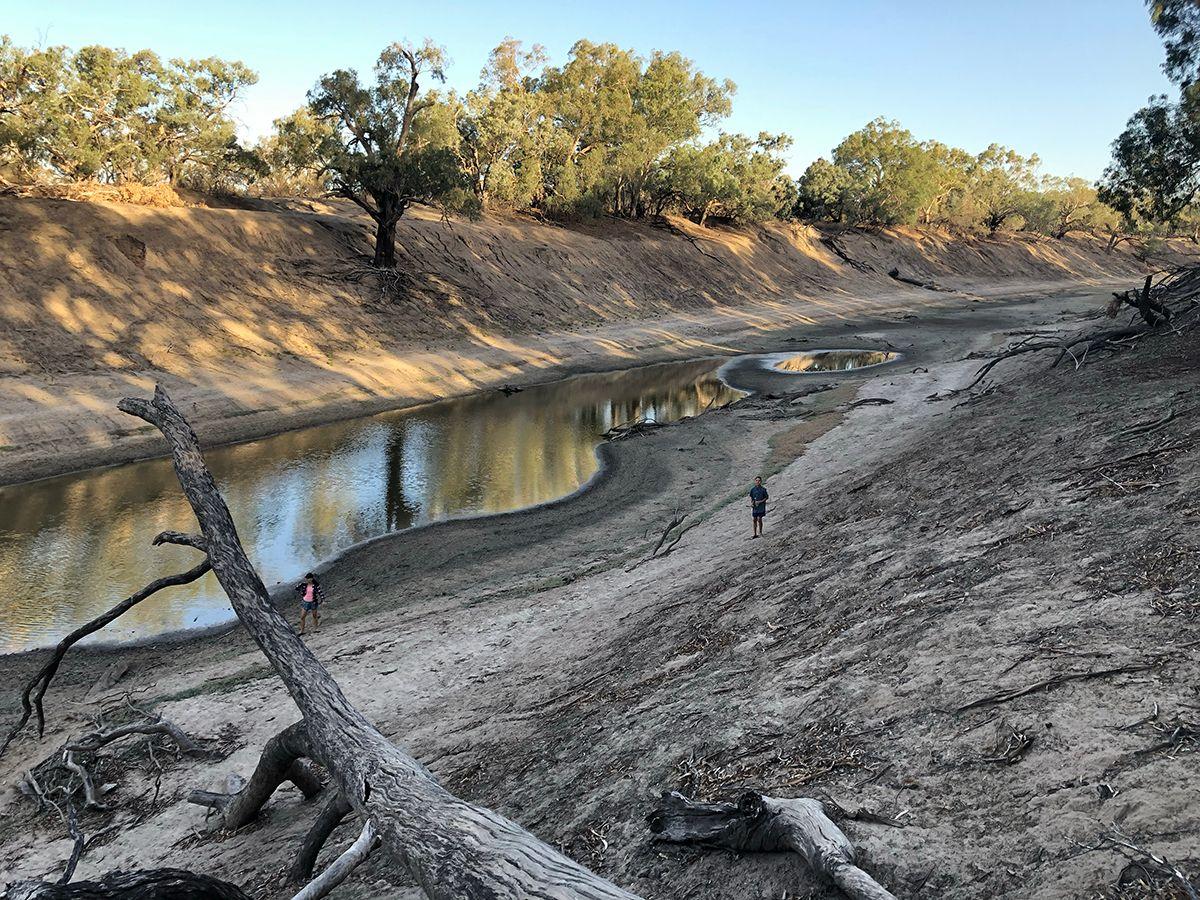Water-theft is a major issue for the environment in the Murray-Darlin Basin; inconsistent laws are a big part of the problem

The Darling River near Louth NSW during drought in 2019. Image: Jaana Dielenberg
News story
22 April 2024
Water is being stolen in the Murray-Darling Basin and it is the environment and taxpayers who fund much-needed environmental flows who bear the cost.
Water is one of Australia’s most valuable commodities, worth almost A$100 billion in the Murray-Darling Basin (MDB). But some of that water is being stolen (no-one knows how much) and the thieves usually get away with it.
In recent decades, water rights have been purchased by the Federal government to support modest and critically needed environmental flows that nourish species habitat and enable fish and waterbird breeding. These holdings represent a huge investment in the national good.
Agricultural water users have set water entitlements which they can also buy and sell through the water market should they have surplus allocation or need more. When agricultural water users simply take more than their water entitlement it is theft and reduces environmental flows in already stressed rivers. Anyone caught stealing environmental water should be prosecuted to the full extent of the law.
But therein lies a problem. The MDB Inspector General of Water Compliance, Mr Troy Grant, has publicly stated that inconsistent MDB State (i.e., Queensland, New South Wales, Victoria, South Australia, and the Australia Capital Territory) water theft laws have resulted in dropped cases. The IGWC was forced to drop 62 cases in February 2023 due to poor state legislative support, inconsistent approaches to water theft, and allowances for some irrigators to balance their accounts in arrears.
Dropped cases lead to questions about water values, continued supply reliability, the extent of environmental harm, and the future security of water rights. It also leads to lower environmental benefits and questions about why we invested billions into ensuring a transfer of rights to the environmental watering program.

New research published in Nature Water led by Associate Professor Adam Loch at The University of Adelaide identified and examined the many relevant laws operating in the basin and the importance of the laws in protecting environmental water as water supply diminishes over coming decades in line with predictions.
Echoing the findings of the MDB Inspector General of Water Compliance the research team found differences in the laws between states including large differences in maximum penalties for water theft.
When the MDB suffers another drought, it is likely water theft will become a top concern for all involved, particularly regulators at state and federal levels. Drought equally impacts private irrigation rights and outcomes and public environmental watering activity.
Where private users see their right as ones of higher priority—and question the legitimacy of environmental rights by stealing those rights—it sends negative signals to all that rely on that water right to enable ecosystem benefits (e.g., species breeding events).
Runoff and in stream water is predicted to substantially decline across the Murray-Darling Basin in coming decades, possibly motivating more theft.
Combining rainfall and runoff data from the Bureau of Meteorology with climate projections from the CSIRO Climate Futures Model and the BoM Water Database the team generated a model of future water flows into the southern Murray-Darling Basin up to 2100. Less rain and higher evaporation rates mean less water will runoff the land into streams, rivers, and storages.
The study found we’re on track for a water runoff catastrophe by around 2060, and the eventual collapse of the river’s systems by around 2080.
To improve outcomes the team recommend building on aspects of water theft policy and legal frameworks that are working. This includes using the “pyramid” approach to assess cases and apply penalties. Most Murray-Darling Basin states already follow this tiered framework of increasing severity, and it could be applied universally throughout the basin to improve outcomes and consistency across the basin.

This is the tiered approach to assess cases and apply penalties used by the NSW Natural Resource Access Regulator. Applying this approach across the Murray-Darlin Basin would improve consistency, the security of water rights and the protection of environmental flows.
Another current issue is some States appear unwilling to “climb to the top” of the pyramid and initiate court proceedings against the most egregious offenders. Consistency across the basin in compliance, including prosecutions and the application of penalties, will help restore confidence in the water market, and ultimately ensure the Murray-Darling’s environmental water flows are protected from thieves.
Such penalties may also garner a wider and much needed appreciation of the value of the environment and its services. There is evidence emerging that the courts find this environmental harm quantification process difficult, potentially leading to lower deterrence.
Do date progress on these matters has been slow. This is deeply concerning, especially as water flows into the basin will dwindle as the climate changes. The research team hope their analysis will encourage prompt attention to tackle water-theft adequately and consistently across the basin’s states.
The next step of the research involves in-depth review of cases and outcomes to better inform those changes.
This article summarises findings from the following peer-reviewed paper: Loch, A., Croft, M., Adamson, D. et al. (2024) Assessing effective deterrence of theft in transboundary water systems. Nature Water. https://doi.org/10.1038/s44221-024-00223-8













